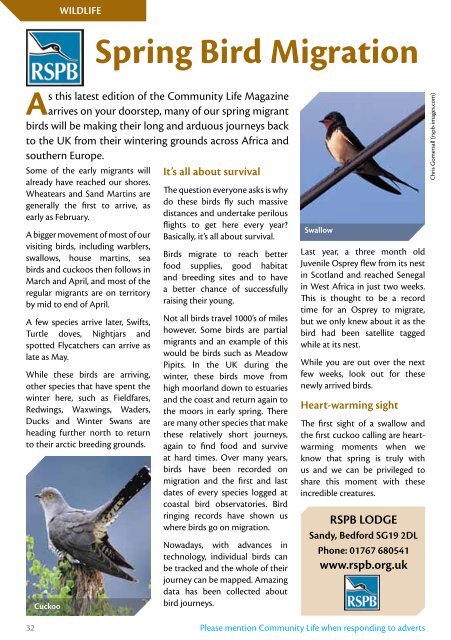Community Life Magazine March13
You also want an ePaper? Increase the reach of your titles
YUMPU automatically turns print PDFs into web optimized ePapers that Google loves.
WILDLIFE<br />
Some of the early migrants will<br />
already have reached our shores.<br />
Wheatears and Sand Martins are<br />
generally the first to arrive, as<br />
early as February.<br />
A bigger movement of most of our<br />
visiting birds, including warblers,<br />
swallows, house martins, sea<br />
birds and cuckoos then follows in<br />
March and April, and most of the<br />
regular migrants are on territory<br />
by mid to end of April.<br />
A few species arrive later, Swifts,<br />
Turtle doves, Nightjars and<br />
spotted Flycatchers can arrive as<br />
late as May.<br />
While these birds are arriving,<br />
other species that have spent the<br />
winter here, such as Fieldfares,<br />
Redwings, Waxwings, Waders,<br />
Ducks and Winter Swans are<br />
heading further north to return<br />
to their arctic breeding grounds.<br />
Spring Bird Migration<br />
As this latest edition of the <strong>Community</strong> <strong>Life</strong> <strong>Magazine</strong><br />
arrives on your doorstep, many of our spring migrant<br />
birds will be making their long and arduous journeys back<br />
to the UK from their wintering grounds across Africa and<br />
southern Europe.<br />
Cuckoo<br />
It’s all about survival<br />
The question everyone asks is why<br />
do these birds fly such massive<br />
distances and undertake perilous<br />
flights to get here every year?<br />
Basically, it’s all about survival.<br />
Birds migrate to reach better<br />
food supplies, good habitat<br />
and breeding sites and to have<br />
a better chance of successfully<br />
raising their young.<br />
Not all birds travel 1000’s of miles<br />
however. Some birds are partial<br />
migrants and an example of this<br />
would be birds such as Meadow<br />
Pipits. In the UK during the<br />
winter, these birds move from<br />
high moorland down to estuaries<br />
and the coast and return again to<br />
the moors in early spring. There<br />
are many other species that make<br />
these relatively short journeys,<br />
again to find food and survive<br />
at hard times. Over many years,<br />
birds have been recorded on<br />
migration and the first and last<br />
dates of every species logged at<br />
coastal bird observatories. Bird<br />
ringing records have shown us<br />
where birds go on migration.<br />
Nowadays, with advances in<br />
technology, individual birds can<br />
be tracked and the whole of their<br />
journey can be mapped. Amazing<br />
data has been collected about<br />
bird journeys.<br />
Swallow<br />
Last year, a three month old<br />
Juvenile Osprey flew from its nest<br />
in Scotland and reached Senegal<br />
in West Africa in just two weeks.<br />
This is thought to be a record<br />
time for an Osprey to migrate,<br />
but we only knew about it as the<br />
bird had been satellite tagged<br />
while at its nest.<br />
While you are out over the next<br />
few weeks, look out for these<br />
newly arrived birds.<br />
Heart-warming sight<br />
The first sight of a swallow and<br />
the first cuckoo calling are heartwarming<br />
moments when we<br />
know that spring is truly with<br />
us and we can be privileged to<br />
share this moment with these<br />
incredible creatures.<br />
RSPB LODGE<br />
Sandy, Bedford SG19 2DL<br />
Phone: 01767 680541<br />
www.rspb.org.uk<br />
32 Please mention <strong>Community</strong> <strong>Life</strong> when responding to adverts<br />
Chris Gomersall (rspb-images.com)









